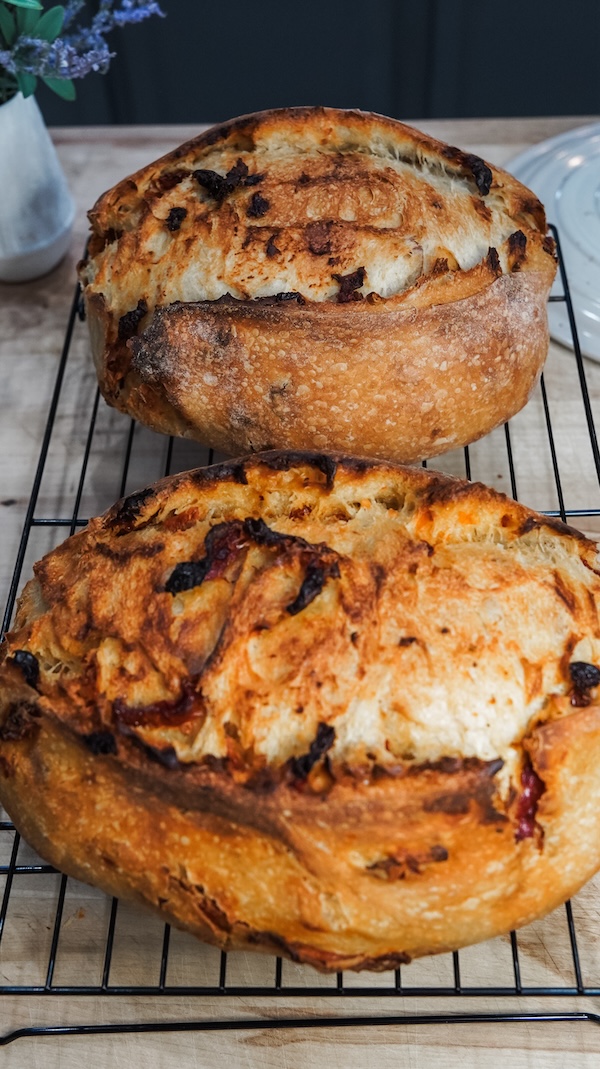
Sundried Tomato and Goat Cheese Sourdough Bread Recipe
Sweet sundried tomatoes and tangy, creamy goat cheese combine to make a unique, incredible loaf of sourdough bread. This is my favorite sandwich bread, and it also makes a killer base for avocado toast.
Ingredients
Sourdough Starter
- 15 g sourdough starter (active or discard)
- 75 g water
- 75 g bread flour (unbleached, King Arthur)
Main Dough
- 485 g bread flour (unbleached, King Arthur)
- 15 g whole wheat flour (optional; substitute for more bread flour if desired)
- 120 g active sourdough starter (from above)
- 330 g warm water
- 10 g salt
Inclusions
- 8.5 oz sun-dried tomatoes in oil (drained and chopped)
- 2 oz goat cheese
Instructions
Feed Your Starter
- The night before making your dough, feed your starter a 1:5:5 feeding ratio by mixing 15 g sourdough starter, 75 g water, and 75 g bread flour. This gives you 45 extra grams, so you don’t have to scrape the jar clean (use the leftovers to maintain your starter). At this ratio, your starter should peak in 10-12 hours.
- Starting in the morning instead? Use a 1:1:1 ratio for a faster peak (4-6 hours). Combine 50 g starter, 50 g water, and 50 g bread flour.
Make the Dough
- In the morning, when your starter has peaked (see Recipe Notes for help), mix 485 g bread flour, 15 g whole wheat flour, 120 g active sourdough starter, 330 g warm water, and 10 g salt. Mix until the ingredients are fully combined and the dough is shaggy. Cover the bowl with plastic wrap, a shower cap, or a cloth, and let it rest for 30 minutes. (This is the beginning of the bulk fermentation.)
Stretch and Folds
- Stretch & Fold 1: Do the first set of stretch and folds. Cover and let rest 30 minutes.
- Stretch & Fold 2: Incorporate the 8.5 oz sun-dried tomatoes in oil (drained and chopped) and 2 oz goat cheese during the second set of stretch and folds. Add a quarter of the inclusions at a time, layering them evenly as you perform each fold to ensure even distribution. Cover and let rest 30 minutes.
- Stretch & Fold 3: Perform the third set of stretch and folds. Cover and let rest 30 minutes.
- Stretch & Fold 4: Perform the last set of stretch and folds. Cover and let rest 30 minutes.If the dough feels particularly weak, you may add a fifth set after waiting another 30 minutes. Once you've completed all rounds of stretch and folds, cover the dough and let it rest until bulk fermentation is complete.
Bulk Fermentation
- Bulk fermentation is done when the dough is visibly larger (the exact percentage rise is not as important as the other visual signs), with bubbles all around the sides and underneath the surface. The dough should jiggle like jelly when you shake the bowl and feel light, airy, and puffy to the touch. It should be domed on the edges where the dough meets the bowl.Don’t worry about exact timing; trust these visual and tactile cues to guide you. Warmer dough ferments faster, colder dough takes longer, but slightly overproofed dough often makes better bread than underproofed. Don't be afraid to push the limits.For this recipe, my bulk fermentation took 8 hours at a 70°F (21°C) average temperature. Another test at 75°F (24°C) took just under 6 hours.
Shape the Dough
- Pre-shape the dough. Mist your work surface with water (or lightly flour it if you prefer). Gently turn the dough out of the bowl. Using a push and pull motion, shape the dough ball into a round shape. We want the surface to be taut. Let rest, uncovered, for about 20 minutes, or just until the dough relaxes a bit.
- Final shaping. Flip the dough and use the caddy clasp final shaping technique to fold it into a boule or batard. See the Notes section for video tutorials.
Cold Retard
- Cover banneton and refrigerate overnight. Ideal cold retard: 12-36 hours. Do not exceed 96 hours.
Score and Bake
- Preheat oven to 450°F (230°C) with Dutch oven inside. Transfer dough to parchment paper or a silicone bread sling, score, and place in Dutch oven.
- Bake with lid on for 30 minutes. Remove lid, lower temperature to 425°F/215°C, and bake for 15-20 minutes, or until golden brown and the internal temperature reaches 205-210°F (96-99°C).
- Cool on a wire rack for at least 2 hours before slicing.
Notes
Caddy clasp for a batard shape
Caddy clasp for a boule shape
Not sure when your starter has peaked? Check out: Is My Sourdough Starter Ready to Bake With? How I Can Tell
The photos in the recipe card show two loaves but please note the recipe as written makes one loaf.
Did you make this recipe?Please leave a comment below!




